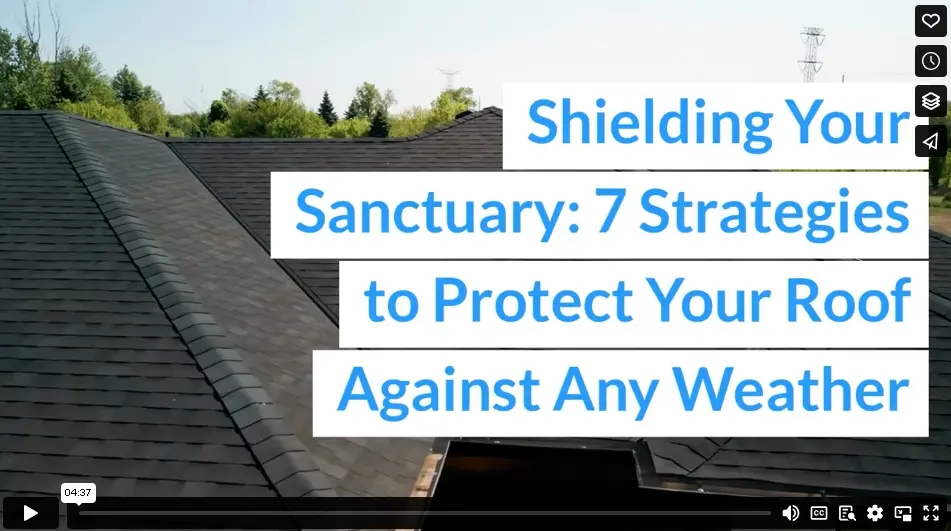Your roof stands as the vigilant guardian of your home, braving the elements day in and day out. From the scorching Salt Lake sun to relentless rain and the icy embrace of Utah’s winter, it shields your home from nature’s relentless assault.
However, like any defender, your roof requires fortification to withstand these challenges. Just as you wouldn’t send soldiers into battle without food and equipment, you can’t expect your roof to perform at the highest level without giving it what it needs. In this guide, we’ll explore seven strategies to protect your roof from the whims of weather, ensuring your home remains a safe haven in any type of storm.
1. Start with Quality Roofing Materials
A knight wouldn’t go into battle with paper armor. He knows that a warrior’s protection is only as strong as the material it’s made of. The same is true for your roof.
When the time comes to replace your roof, invest in high-quality materials. With the help of your roofing expert, you can find materials designed to withstand the specific weather conditions of your location. Roofing contractors in Utah are familiar with the products that will provide the best armor against our weather conditions in your area.
2. Choose your Contractor Carefully
A fantastic roof product won’t do much good if it isn’t correctly installed. High-quality materials can’t overcome low-quality work. When you need your roof to go up against nature’s fury, you need it installed soundly by a knowledgeable, experienced roofing contractor.
3. Perform Regular Inspections
Just as a general inspects his forces before sending them into battle, you should inspect your roof to make sure it passes muster before the next storm hits. Spending several moments looking at your roof every few months can catch problems before they spread. Look for cracked or missing shingles, sagging areas, and signs of water damage, such as mold or mildew growth. Do any sections of the roof look crooked or warped? Areas of discoloration are another sign of potential problems.
While periodic roof surveys can catch some issues, it’s best to have a professional roof inspection as your roof ages. You may also want to call in the experts after a significant weather event. They can get up close and personal with your roof to ensure that recent weather didn’t do any damage. If they see issues, they can make repairs before the next storm causes even more significant problems to the exterior or interior of your home.
4. Trim Landscaping
Overhanging branches scrape against your roof materials. High winds can mean those branches drag repeatedly across your roof. Over time, that can degrade your shingles. With enough force, a branch could even tear a shingle away from the underlayment.
Even if the branches are several feet above your roof, they aren’t safe. Wind can cause them to flex and bend. With the added weight of water, ice, or snow, they can easily sag to reach the roof. Weather can also cause branches to snap, crash onto your roof, and cause damage. It’s best to create a “no branch zone” over your roof and several feet around its perimeter.
5. Maintain Proper Ventilation
Your attic is the lungs of your home. It’s essential for your home’s health to have sufficient air exchange. That happens through your attic and its vents. Proper ventilation helps maintain regular temperatures and moisture levels. Hot, damp air escapes through vents and is replaced by fresh air. That means in the summer, your ventilation system prevents excessive heat, and in the winter, it prevents condensation that can lead to rot or mold.
If you are concerned that your roof doesn’t have sufficient ridge and soffit vents or other means of air exchange, consult a roofing expert.
6. Seal any Gaps
Your roof should be impenetrable to the elements, like a knight’s suit of armor. If you notice gaps in your roof, seal them immediately or call for professional help to ensure the job is done correctly.
Pay special attention to areas around skylights, chimneys, vents, or other penetration points in the roof. These are all common sources of problems.
When the weather comes, you want to make sure it stays outside. Closing off entry points keeps out rain, snow, ice, wind, or hot summer air.
7. Snow and Ice Removal
This step is critical for areas like Utah, where we get fierce, snowy winters. Remove snow and ice build-up. Failure to do so presents a hazard not only to your roof but to anyone who happens to be standing below when a mass of snow or ice lets go and crashes to the ground.
Use a roof rake to carefully clear snow build-up as far up as possible. Do this after each significant snowfall. If you can’t safely perform this task, hire a professional. Getting rid of frozen build-up prevents ice dams, safety hazards, and damage to your roof and the underlying structure.
When healthy, your roof is a steadfast sentinel, protecting your home from nature’s fury. By properly caring for your roof, you help it care for you and your home. Fortify your roof’s defenses against the elements, allowing it to be your knight in shining armor against any weather for years to come.
Video
Infographic
Your roof is the steadfast guardian of your home, facing Utah’s harsh sun, rain, and icy winters. Read on to discover seven strategies to protect your home from the elements and keep it safe in any storm in this infographic.


